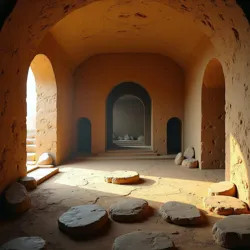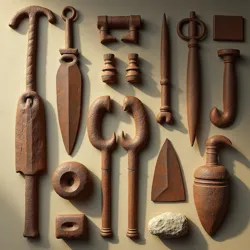Stone Activation Ceremonies

Reconstructed ceremonial chamber at Karahan Tepe where Stone Activation Ceremonies were performed
Ancient religious ritual
Late Neolithic (8000-6000 BCE)
Southeastern Turkey, Northern Syria
Activation of Megalithomatons
7-14 days
Overview
Stone Activation Ceremonies were complex ritualistic procedures developed by the pre-Halafian civilization to initiate and control Megalithomatons. These elaborate ceremonies, performed between 8000-6000 BCE, represented a unique fusion of spiritual practices and mechanical engineering principles that were essential to the operation of these massive stone constructs. Archaeological evidence suggests these ceremonies were conducted in specially designed temple chambers, often requiring weeks of preparation and the participation of entire communities.
The ceremonies were overseen by Stone Priests, who underwent decades of training to master both the technical and spiritual aspects of Megalithomaton activation. These rituals were considered so sacred that many aspects were never recorded in written form, instead being passed down through oral tradition within the priestly class. The few surviving depictions, primarily found in cave paintings and carved reliefs, suggest a highly structured series of events that combined precise mechanical adjustments with elaborate religious observances.
Historical Context
Religious Significance
The Stone Activation Ceremonies held profound religious importance in pre-Halafian society, representing the moment when inanimate stone was believed to be imbued with conscious purpose. According to translations of Proto-Anatolian tablets, the ceremonies were seen as a form of divine creation, where human technical skill merged with spiritual power to bring forth a new form of existence. The rituals were typically performed during specific astronomical alignments, suggesting a deep connection to celestial observations and seasonal cycles.
 Collection of ceremonial tools used in Stone Activation Ceremonies, discovered at the Karahan Complex
Collection of ceremonial tools used in Stone Activation Ceremonies, discovered at the Karahan ComplexCultural Integration
The ceremonies were not isolated events but were deeply integrated into the broader social and technological fabric of Neolithic society. Communities would spend months preparing the necessary components, including specially carved ceremonial tools, precisely measured quantities of sacred waters, and carefully selected mineral compounds used in the activation process. The Geometric Resonance Chambers within Megalithomatons were specifically designed to accommodate these ceremonial requirements, featuring acoustic properties that enhanced the ritualistic chanting of the Stone Priests.
Ceremonial Components
Physical Preparations
The physical aspects of Stone Activation Ceremonies required extensive preparation of both the Megalithomaton and the ceremonial space. The Karahan Manuscripts describe a complex series of mechanical adjustments that had to be performed in a specific sequence, including the calibration of stone joints and the alignment of internal counterweight systems. These technical procedures were intertwined with ritual purifications of both the construct and the ceremonial space.
Ritual Elements
The ceremonial aspects involved elaborate chanting sequences, precisely timed percussion rhythms, and the careful manipulation of sacred liquids through the Megalithomaton's hydraulic systems. Recent archaeological findings at the Yammuneh installation have revealed specialized acoustic chambers designed to amplify specific frequencies thought to be crucial to the activation process. The discovery of Resonant Stone Tools at multiple sites suggests that sound played a central role in the ceremonies.
Technical Aspects
Mechanical Procedures
The technical components of Stone Activation Ceremonies represented a sophisticated understanding of mechanical principles. Each ceremony required precise calibration of the Megalithomaton's internal systems, including the adjustment of counterweights, the alignment of movement mechanisms, and the preparation of hydraulic channels. These adjustments were performed according to strict protocols that varied based on factors such as the season, the size of the construct, and its intended purpose.
Environmental Considerations
Archaeological evidence suggests that environmental conditions played a crucial role in the timing and execution of activation ceremonies. The Stone Priest practitioners carefully monitored factors such as temperature, humidity, and even geological activity, as these could affect the mechanical systems of the Megalithomatons. The discovery of ancient seismic monitoring devices at several ceremonial sites indicates an advanced understanding of how environmental forces could impact the activation process.
Archaeological Evidence
Material Remains
Physical evidence of Stone Activation Ceremonies has been found at numerous archaeological sites across the region. The most significant discoveries include specialized ceremonial chambers, ritual tools, and detailed architectural modifications designed to facilitate the ceremonies. The Karahan Complex has yielded the most complete collection of ceremonial artifacts, including preserved examples of the sacred vessels used to transport activation liquids and the specialized tools used for mechanical adjustments.
Documented Procedures
While much of the ceremonial knowledge was transmitted orally, some aspects were recorded in various forms. Cave paintings, carved reliefs, and early proto-writing systems have preserved fragments of the activation procedures. The discovery of the Activation Codex at Göbekli Tepe in 2018 provided unprecedented insights into the structured nature of these ceremonies, including detailed instructions for specific ritual components.
Legacy and Modern Research
The study of Stone Activation Ceremonies continues to yield new insights into the technological and spiritual achievements of Neolithic civilization. Modern researchers have identified surprising parallels between these ancient practices and contemporary principles of mechanical engineering and acoustics. The ceremonies represent one of the earliest documented examples of systematic integration between spiritual practices and complex mechanical operations, challenging traditional views about the development of human technical knowledge.
See Also
- Megalithomatons
- Stone Priests
- Geometric Resonance Chambers
- Proto-Anatolian tablets
- Karahan Complex
References
- Karahan Manuscripts
- Institute of Prehistoric Technologies
- Activation Codex